Sean Connery Original Off Negative Gelatin Silver Photograph 007 James Bond
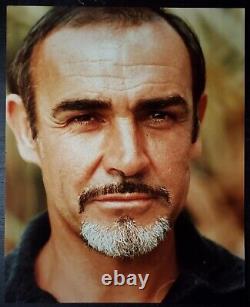
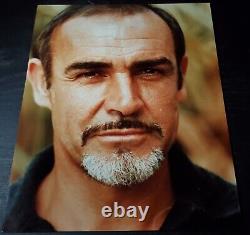
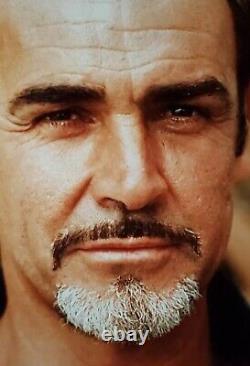
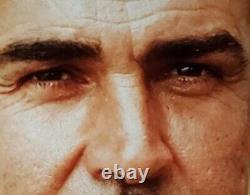
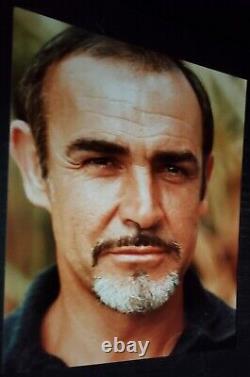
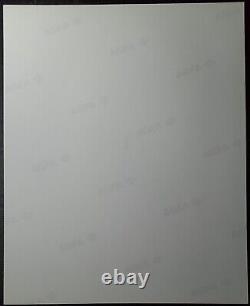



This Sean Connery original Gelatin Silver processed color photograph is the exact item you will receive and has been certified Authentic by REM Fine Collectibles. Sir Thomas Sean Connery (born 5 August 1930 - 31 October 2020), known as Sean Connery, was a Scottish actor. He was the first actor to portray fictional British secret agent James Bond on film, starring in seven Bond films between 1962 and 1983.
Originating the role in Dr. No, Connery played Bond in six of Eon Productions' entries and made his final appearance in Never Say Never Again. Following his third appearance as Bond in Goldfinger (1964), in June 1965 Time magazine observed "James Bond has developed into the biggest mass-cult hero of the decade".
Connery began acting in smaller theatre and television productions until his breakout role as Bond. Although he did not enjoy the off-screen attention the role gave him, the success of the Bond films brought Connery offers from notable directors such as Alfred Hitchcock, Sidney Lumet and John Huston. Their films in which Connery appeared included Marnie (1964), The Hill (1965), Murder on the Orient Express (1974), and The Man Who Would Be King (1975). He also appeared in A Bridge Too Far (1977), Highlander (1986), The Name of the Rose (1986), The Untouchables (1987), Indiana Jones and the Last Crusade (1989), The Hunt for Red October (1990), Dragonheart (1996), The Rock (1996), and Finding Forrester (2000). His achievements in film were recognised with an Academy Award, two BAFTA Awards (including the BAFTA Fellowship), and three Golden Globes, including the Cecil B.
DeMille Award and a Henrietta Award. In 1987, he was made a Commander of the Order of Arts and Letters in France, and he received the US Kennedy Center Honors lifetime achievement award in 1999. Connery was knighted in the 2000 New Year Honours for services to film drama.Seeking to supplement his income, Connery helped out backstage at the King's Theatre in late 1951. During a bodybuilding competition held in London in 1953, one of the competitors mentioned that auditions were being held for a production of South Pacific, and Connery landed a small part as one of the Seabees chorus boys.
By the time the production reached Edinburgh, he had been given the part of Marine Cpl. While in Edinburgh, Connery was targeted by the Valdor gang, one of the most violent in the city. He was first approached by them in a billiard hall where he prevented them from stealing his jacket and was later followed by six gang members to a 15-foot-high (4.6 m) balcony at the Palais de Danse. There, Connery singlehandedly launched an attack against the gang members, grabbing one by the throat and another by the biceps and cracking their heads together. From then on, he was treated with great respect by the gang and gained a reputation as a "hard man".In early 1957, Connery hired agent Richard Hatton who got him his first film role, as Spike, a minor gangster with a speech impediment in Montgomery Tully's No Road Back alongside Skip Homeier, Paul Carpenter, Patricia Dainton, and Norman Wooland. In April 1957, Rakoff - after being disappointed by Jack Palance - decided to give the young actor his first chance in a leading role, and cast Connery as Mountain McLintock in BBC Television's production of Requiem for a Heavyweight, which also starred Warren Mitchell and Jacqueline Hill. He then played a rogue lorry driver, Johnny Yates, in Cy Endfield's Hell Drivers (1957) alongside Stanley Baker, Herbert Lom, Peggy Cummins, and Patrick McGoohan.
Later in 1957, Connery appeared in Terence Young's poorly received MGM action picture Action of the Tiger opposite Van Johnson, Martine Carol, Herbert Lom, and Gustavo Rojo; the film was shot on location in southern Spain. He also had a minor role in Gerald Thomas's thriller Time Lock (1957) as a welder, appearing alongside Robert Beatty, Lee Patterson, Betty McDowall, and Vincent Winter; this commenced filming on 1 December 1956 at Beaconsfield Studios. Connery had a major role in the melodrama Another Time, Another Place (1958) as a British reporter named Mark Trevor, caught in a love affair opposite Lana Turner and Barry Sullivan. During filming, Turner's possessive gangster boyfriend, Johnny Stompanato, who was visiting from Los Angeles, believed she was having an affair with Connery. Connery and Turner had attended West End shows and London restaurants together. Stompanato stormed onto the film set and pointed a gun at Connery, only to have Connery disarm him and knock him flat on his back. Stompanato was banned from the set. Two Scotland Yard detectives advised Stompanato to leave and escorted him to the airport, where he boarded a plane back to the United States. Connery later recounted that he had to lay low for a while after receiving threats from men linked to Stompanato's boss, Mickey Cohen.Connery's breakthrough came in the role of British secret agent James Bond. He was reluctant to commit to a film series, but understood that if the films succeeded, his career would greatly benefit. Between 1962 and 1967, Connery played 007 in Dr.
No, From Russia with Love, Goldfinger, Thunderball, and You Only Live Twice, the first five Bond films produced by Eon Productions. Connery made his final appearance as Bond in Never Say Never Again, a 1983 remake of Thunderball produced by Jack Schwartzman's Taliafilm. All seven films were commercially successful. James Bond, as portrayed by Connery, was selected as the third-greatest hero in cinema history by the American Film Institute. Connery's selection for the role of James Bond owed a lot to Dana Broccoli, wife of producer Albert "Cubby" Broccoli, who is reputed to have been instrumental in persuading her husband that Connery was the right man. James Bond's creator, Ian Fleming, originally doubted Connery's casting, saying, "He's not what I envisioned of James Bond looks, " and "I'm looking for Commander Bond and not an overgrown stunt-man", adding that Connery (muscular, 6' 2, and a Scot) was unrefined. Fleming's girlfriend Blanche Blackwell told him Connery had the requisite sexual charisma, and Fleming changed his mind after the successful Dr. He was so impressed, he wrote Connery's heritage into the character. In his 1964 novel You Only Live Twice, Fleming wrote that Bond's father was Scottish and from Glencoe in the Scottish Highlands. Onnery's portrayal of Bond owes much to stylistic tutelage from director Terence Young, who helped polish him while using his physical grace and presence for the action. Lois Maxwell, who played Miss Moneypenny, related that Terence took Sean under his wing. He took him to dinner, showed him how to walk, how to talk, even how to eat.The tutoring was successful; Connery received thousands of fan letters a week after Dr. No's opening, and he became a major sex symbol in film. Following the release of the film Dr. No in 1962, the line Bond... James Bond, became a catch phrase in the lexicon of Western popular culture.
[60] Film critic Peter Bradshaw writes, It is the most famous self-introduction from any character in movie history. Three cool monosyllables, surname first, a little curtly, as befits a former naval commander.
And then, as if in afterthought, the first name, followed by the surname again. Connery carried it off with icily disdainful style, in full evening dress with a cigarette hanging from his lips. The introduction was a kind of challenge, or seduction, invariably addressed to an enemy. In the early 60s, Connery's James Bond was about as dangerous and sexy as it got on screen. During the filming of Thunderball in 1965, Connery's life was in danger in the sequence with the sharks in Emilio Largo's pool. He had been concerned about this threat when he read the script. Connery insisted that Ken Adam build a special Plexiglas partition inside the pool, but this was not a fixed structure, and one of the sharks managed to pass through it. He had to abandon the pool immediately. I'd like to kill him. Michael Caine said of the situation, If you were his friend in these early days you didn't raise the subject of Bond. He was, and is, a much better actor than just playing James Bond, but he became synonymous with Bond. He'd be walking down the street and people would say,'Look, there's James Bond'.That was particularly upsetting to him. Connery was knighted by the Queen at an investiture ceremony at Holyrood Palace in Edinburgh on 5 July 2000.
He had been nominated for a knighthood in 1997 and 1998, but these nominations were reportedly vetoed by Donald Dewar owing to Connery's political views. Connery had a villa in Kranidi, Greece. His neighbour was King Willem-Alexander of the Netherlands, with whom he shared a helicopter platform.Michael Caine (who co-starred with Connery in The Man Who Would Be King in 1975) was among Connery's closest friends. Diamonds Are Forever is a 1971 spy film, the seventh in the James Bond series produced by Eon Productions. The film is based on Ian Fleming's 1956 novel of the same name and is the second of four James Bond films directed by Guy Hamilton. The story has Bond impersonating a diamond smuggler to infiltrate a smuggling ring and soon uncovering a plot by his old enemy Ernst Stavro Blofeld to use the diamonds to build a space-based laser weapon.
Bond has to battle his enemy for one last time to stop the smuggling and stall Blofeld's plan of destroying Washington, D. And extorting the world with nuclear supremacy.
After George Lazenby left the series, producers Harry Saltzman and Albert R. The producers were inspired by Goldfinger; as with that film, Guy Hamilton was hired to direct, and Shirley Bassey performed vocals on the title theme song. Locations included Las Vegas, California, and Amsterdam. Diamonds Are Forever was a commercial success and received generally positive reviews.
Anwar Hussein (born 1938) is a Tanganyika-born British photo journalist and author. In 2016 he became the longest-serving photographer covering the British royal family and Queen Elizabeth II. Hussein is notable for changing perceptions of royal family through the use of casual photographs instead of formal portrait photography. In the 1960s, Anwar mainly covered events such as the Isle of Wight festival. His flair for captivating portraits and his reports from artists such as Rod Stewart, Elton John, John Lennon and Yoko Ono, The Who, Bob Marley, The Bee Gees and The Sex Pistols have made him one of the most sought after photographers from the rock era.In the mid-1970s, Anwar's work took an important turn for his career when he became a stage photographer for classic films like The 24 Hours of Mans, Papillon, Tommy and the Bond movies. After this period, Anwar decided to focus his talents on the British Royal Family photograph. From the beginning, the latter was confronted with hostilities. Indeed he had the reputation of photographing rock stars and cinema, and some members of the royal entourage were then reluctant. Anwar was determined to follow and photograph the Royal Family by imposing her own style.
From then on, all the British press agencies snapped up their clichés. The Royal family opens his doors and invites him to photograph their moments of intimacy. At the time of Prince Charles's engagement with Diana Spencer, Anwar is named "official royal photographer". This item is in the category "Art\Art Photographs". The seller is "rem-fc" and is located in this country: US.
This item can be shipped to United States.
- Unit of Sale: Single Piece
- Image Orientation: Portrait
- Size: 8 x 10 in
- Signed: No
- Custom Bundle: No
- Image Color: Color
- Material: Gloss Paper
- Framing: Unframed
- Original/Licensed Reprint: Original
- Subject: Actors, Sean Connery, James Bond, 007
- Personalize: No
- Type: Photograph
- Year of Production: 1971
- Photographer: Anwar Hussein
- Style: Documentary, Photojournalism
- Features: 1st Edition, One of a Kind (OOAK)
- Time Period Manufactured: 1970-1979
- Production Technique: Gelatin-Silver Print
- Country/Region of Manufacture: United Kingdom
- Finish: Glossy
- Culture: Film

